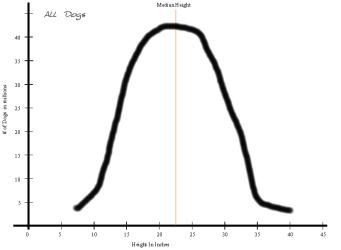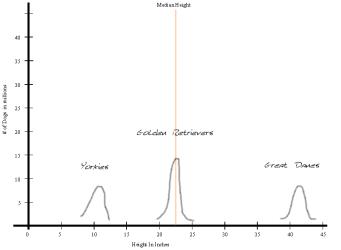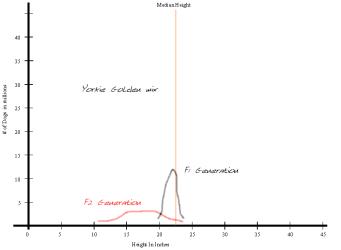
This article started out as a post to an e-mail list with regard to genetics and health. It is somewhat long but I hope you read through to the end and gain something from it. I've modified it somewhat by removing references to specific dogs where they existed to make it a more general piece.
Ok, this is going to be a somewhat long post and I may have to break it up to get it to go through to the list so bear with me.
A couple of people have asked some very good questions.
1) Why did I bother going so far back into the pedigrees.2) Why not tell stories about successes/failures with various breeding methods.
I will get to these, but keep them in the back of your mind while reading.
Genetics is to a large degree dealing with statistics and probabilities. It is not absolutes.
If we all think about that old dreaded bell shaped curve we remember from school, especially with regard to grading papers. Ewwwww. Well, the bell curve figures fairly predominantly into genetics.
Here's a diagram I had made up for a different discussion quite some time ago but can be utilized here.
Typical bell shaped curve:

This curve was set up to talk about heights. Dog as a species range from the tiny little toy dogs up to the giant breeds. But if you looked at the height of the species over all you would find a bell shaped curve. You'll have some really tiny dogs at one end, some really large dogs at the other but the vast majority of dogs will be in the middle.
That brings us to chart 2:

What we have done through selective breeding is to narrow the bell shaped curve so that it falls in a curve around the "breed standard". In doing that we have eliminated the genes that would produce a tiny dog as well as those that would produce a giant dog. If you look at the chart there are 3 curves there. One for yorkies, one for goldens and one for great danes. The vast majority of goldens are going to fall within the range of 20.5 inches to 25 inches at the shoulder. There are going to be some that fall above those numbers as well as below. But those numbers are going to be relatively low. And the chances of producing a yorkie sized golden are pretty slim because we have with time eliminated those genes.
It is possible with time and selection to shift the bell curves. For example when I first got involved with goldens they were tending towards the uppper end of the breed standard. So if you had been able to generate a bell curve of the dogs that lived at that time the curve would fall a little further to the right of the midpoint. And that is how with time you can through selection change certain traits.
When you breed for certain traits you are by definition breeding away from others. With time the genes that produce those traits that you are breeding away from are lost. Basically use it or lose it. Purebreds by definition have narrower gene pools than the species as a whole. That's what makes a golden a golden a yorkie a yorkie, etc, etc, etc. They are genetically more consistant or what is called homozygous.
Because of that homozygosity the chances of producing a yorkie sized golden are very slim.
Which brings us to chart 3:

The ultimate out-cross. A cross-breeding between two breeds. If you breed two divergent breeds like say a golden and a yorkie the first or (F1) generation is actually going to be a fairly consistant mix of the two parent breeds. You would get a fairly narrow bell curve located somewhere between the two parent breeds.
If however you take two of those first generation crosses and breed them together you will get a wide variety of heights. You might have some down close to yorkie sized and others up closer to golden sized. Your not likely to get Great Dane sized dogs out of this mix because you haven't added the genes for giant size into the mix.
Here's a link to a graphic that nicely illusrates this point. - Link
So with our breeding of purebreds we are doing the same thing on a smaller scale. The analogy would be that in (and to a lesser extent line breeding) are like breeding pure-strains, you will get much more consistant results. Out-crossing to other lines within the breed would be like cross-breeding, you get more variability within the offspring.
So to answer the second question first. Without even hearing any stories about successes/failures of in vs out crosses I can tell you that the chances that you are going to hear many more success stories about in/line breeding is going to be much higher. Why? Because of how we generally measure the success. By how many of the offspring are successful in a particular venue. The more consistant the offspring the more likely they will be successful.
But as you add more and more selection criteria the number of dogs that you have to choose from goes down.
In a randomly bred population every dog has an equal chance of breeding with any other dog. In such a population if one dog has a deleterious mutation, it will pass that gene on to it's offspring, but because of the limited nature of that dogs contribution to the breed the frequency with which that gene shows up in the population as a whole remains low. And in random breedings the chances that any individual will inherit two copies of that gene remain low as well. So the chances of producing an affected animal in a randomly bred population is low (it is not non-existant which is why mixed breed dogs can and do get the same genetic disorders that purebreds do).
However the chances of getting consistant offspring is lower as well. This is generally why you have sires that tend to be pre-potent. Dogs that are more genetically homozygous (consistant) themselves will produce more consistant offspring.
Even in a randomly bred population with each generation you are going to lose some genes through what is called genetic drift. At this link there's a diagram about 1/3 to 1/2 way down that shows what happens with time.
However, the rate of mutation tends to keep the overall diversity within the population consistant. People generally tend to think of mutations as bad, they aren't, some are beneficial (like maybe increased resistance to a disease), some are benign and some are deleterious (like reduced resistance to a disease).
Selection increases the rate at which we lose genes with each generation.
The link just above also mentions the effective population size. This is where the popular stud situation comes into play. It is based on the number of breedable males and females within a population. In a population where you have more dogs from a wider variety of blood lines being bred you have a larger effective population size than you would if in the same population you funneled most of the breedings through a more limited number of dogs (generally males).
So popular stud use reduces on a breed wide basis the genetic diversity and decreases the effective population size.
Consider this in relation to the post I made the other day where I mentioned that in 1968/69 there were 172 Champions out of 118 different sires or roughly 1.5 Champions per sire. In 1994/95 we had 425 Champions out of 180 different sires or 2.4 Champions per sire. In addition the top producers were producing greater proportions of the Champions. So we are funneling the breedings through fewer and fewer dogs, reducing the breeds effective population size.
What bearing does this have on health. A lot.
When we reduce the amount of genetic diversity based on the outward phenotypes (appearances) we also reduce the amount of diversity of untold other genes that regulate all sorts of other bodily functions.
Let's look at the Major Histiocompatability Complex (MHC) it is a group of genes that basically regulate the bodies immune system. The immune system on the other hand has an impact on everything from the development of arthritis to the bodies ability to fight off infections to the ability to ward off cancers. Research on the MHC has shown that it functions most efficiently when it is genetically diverse.
Because we cannot be selective about how those unseen genes become more consistant we have inadvertantly also reduced the amount of diversity of the genes in the MHC. Do we know how much?
Research going on at UC Davis on Akitas, a breed prone to immune system problems, has shown that of the 32 possible alleles in the MHC the breed has 7. The preliminary reports were careful to say that they cannot definatively say that is the cause of the immune system problems in the breed but it does give them direction for further research.
So by random occurences and selection with time we have reduced the number of available genes, and by funneling so many of the breedings through so relatively few animals we increase the probability that the bad genes that those particular animals carried are going to be expressed.
And this goes back to the question about why go back so far in the pedigree.
There is also whats called the founder effect. Our breed as a whole is limited to only those genes that were present in the founding animals.
One example that is often used is blood types in certain groups. American indians as a group don't tend to have one of the blood types (I can't remember at the moment which one it is). Why not? Because the ancestors on which their tribes are based, by chance didn't have the genes to produce that particular blood type.
So a breed of dog by virtue of being a breed and for the last 100 or so years being a closed gene pool cannot add genes in. The only thing we can do to try and limit how quickly we lose them.
So finally on why look further back in a pedigree.
In a 20 generation pedigree you have the possibility of 2097150 different unique ancestors. The more unique ancestors the more diversity, and the less quickly we lose genes. The more evenly represented the ancestors the less quickly we lose genes and we also lower the chances that you will double up on the bad genes that those animals brought to the genetic table.
But in addition to the bad genes that each animal brought to the genetic table they also brought good genes. And some of those genes very likely were protective in nature. They prevented the bad genes from being expressed. And with time as we select for particular traits and engage in in/line breeding which also hastens inadvertent gene loss we may have also been hastening the loss of those protective genes.
As I said in one of the previous posts the simple Mendelian model of genetics that most people have at least some aquaintance with is (and I originally used the word flawed, but inadequate is probably more accurate) inadequate in dealing with the much larger picture. Look at the research that has come out in just the last few weeks. There are far fewer genes (at least in humans) than originally believed, and each of those genes codes for at least several proteins. How those proteins interact in order to keep us functioning is all interrelated. A gene that we think may code for hair color could also code for something related to health. We simply don't know. So it's not simply a matter of identify and eliminate the bad genes, we need to keep as many of the genes as we possibly can, because they may be protecting us from the bad genes.
And on a breed wide basis we need to work harder on not losing those genes.
I hope this makes sense to people. :)
All material contained on this website is copyrighted and the property of the website administrator/owner. Unauthorized use without express written permission of the authors or owners is forbidden.
For any questions about this website contact